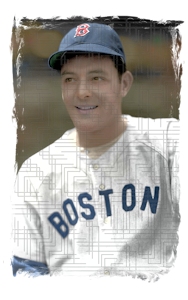 |
Ernie Andres Jr was born on January 11, 1918, in Jeffersonville, Indiana. He went to McCullough’s School, then graduated from Jeffersonville High School in 1935 and went to college at Indiana University, graduating in 1939. He was something of a star in college, setting a single-game conference record, scoring 30 points and was named to the All-Big Ten first team in 1938 and 1939. In 1939 he was captain of both the basketball and baseball teams, and twice won the Balfour Award as the college’s top athlete. Signed by the Boston Red Sox in June, he began professional play as soon as he completed college, appearing in 78 games for the Double-A American Association Louisville Colonels in 1939, and batting .298 with four home runs. That winter, Ernie played professional basketball for Indianapolis, and again made the occasional headline. He played in 111 baseball games in 1940 and in all 154 games in 1941 at Louisville, batting .276 and .289. It was clear that war was on the horizon and the armed forces were increasing their numbers. Ernie enlisted in the Navy that June, but was not called until after the baseball season, in September. Before the Japanese attack on Pearl Harbor, he was already stationed at the Great Lakes Naval Training Station. He played basketball there, and was on the first Great Lakes baseball team, a team featuring several former major-league ball players. The Great Lakes Bluejackets played against a number of college and pro teams. On the day after the 1942 major-league All-Star Game, there was another All-Star Game held with a team of Army-Navy All-Stars playing against the winner of the All-Star Game. The American League beat the National League, 3-1, at the Polo Grounds. So it was the A.L. team that played again the following day at Municipal Stadium in Cleveland against the Service All-Star team. The American Leaguers won, 5-0, but for the season, Ernie hit .360 for the Great Lakes team. Andres received his commission as an ensign in October. In late ’43, ’44 he served aboard a submarine chaser. Much of his service was off the coast of Alaska and he was then transferred to Miami training for the sub chaser command. He wound up spending 25 months in Miami teaching sports to sailors there. After he was mustered out of the service as Lt. (J.G.) E. Andres in October, Ernie was quickly signed again by Indianapolis to play pro basketball, and in December, the Red Sox acquired him from their farm club in Louisville. Manager Joe Cronin had been impressed with Ernie, seeing him at Great Lakes and strongly requested that he give up playing basketball at the professional level. Ernie started the first eight games of the 1946 season for the Red Sox, but in April he pulled a leg muscle running out a hit in the second inning and didn’t return to action until May. He got a single on May 12th, but was only batting .098. The Red Sox were 23-6 and five games ahead of the second-place Yankees in the standings at the time. On May 19th, they purchased Mike Higgins from the Tigers and two weeks later, they optioned Ernie to the Buffalo Bisons (International League). It was Ernie's last time in the big leagues. He only got into one game for Buffalo and was sent to Minneapolis. With the Minneapolis Millers, a New York Giants affiliate, he played in 90 games, hit .287 In September, 1947 the Indianapolis basketball club announced that he had rehired Ernie for 1946-47, this time as player-coach. He was reportedly making $15,000 a year. Still on a Louisville Colonels contract, Ernie let them know his basketball commitments would make him report late to spring training. That perhaps didn’t sit well because Louisville sold his contract to the Indianapolis Indians of the American Association, a Pittsburgh Pirates affiliate in 1947. He played in 150 games for the Indians and they were his last games in baseball. In April, 1948, he was named head baseball coach for Indiana University, winning the national championship in 1953. After 25 years as coach, he resigned in 1963 to become field secretary for the Indiana University Alumni Office. He worked for the alumni office for 10 years before retiring. If the NBA was as big in the 1940s as it is today, Ernie Andres might have been a star basketball player. In 1974 was inducted into the Indiana Basketball Hall of Fame and Indiana Baseball Hall of Fame. He passed away on September 19, 2008 in Brandenton, Florida. He was 90 years old. |
|||||
